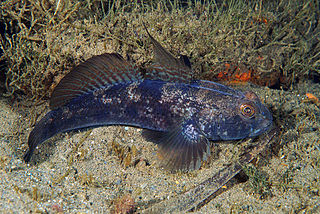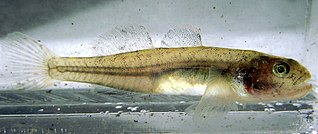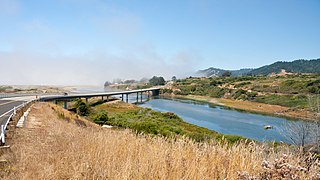
Gobiidae or gobies is a family of bony fish in the order Gobiiformes, one of the largest fish families comprising more than 2,000 species in more than 200 genera. Most of gobiid fish are relatively small, typically less than 10 cm (3.9 in) in length, and the family includes some of the smallest vertebrates in the world, such as Trimmatom nanus and Pandaka pygmaea, Trimmatom nanus are under 1 cm long when fully grown, then Pandaka pygmaea standard length are 9 mm (0.35 in), maximum known standard length are 11 mm (0.43 in). Some large gobies can reach over 30 cm (0.98 ft) in length, but that is exceptional. Generally, they are benthic or bottom-dwellers. Although few are important as food fish for humans, they are of great significance as prey species for other commercially important fish such as cod, haddock, sea bass and flatfish. Several gobiids are also of interest as aquarium fish, such as the dartfish of the genus Ptereleotris. Phylogenetic relationships of gobiids have been studied using molecular data.

Mudskippers are any of the 23 extant species of amphibious fish from the subfamily Oxudercinae of the goby family Oxudercidae. They are known for their unusual body shapes, preferences for semiaquatic habitats, limited terrestrial locomotion and jumping, and the ability to survive prolonged periods of time both in and out of water.

Eucyclogobius newberryi, the northern tidewater goby, is a species of goby native to lagoons of streams, marshes, and creeks along the coast of California, United States. The northern tidewater goby is one of six native goby species of California. It is protected under the Endangered Species Act as an endangered species of the United States since 1994.

The longjaw mudsucker is a species of goby found along the Pacific coast of California and Baja California. Known for its distinctive elongated jaws and robust body, this species can reach up to 21 cm in length, making it one of the larger gobies in its habitat. Adapted to estuarine environments, the longjaw mudsucker has evolved to survive short periods out of water, utilizing tidal mudflats and sloughs as its primary habitat.

Stiphodon is a genus of freshwater gobies. They inhabit swift, clear streams close to the sea and are found in large parts of Asia and Oceania. Many of the 36 currently recognized species have extremely restricted distributions on single islands or even single streams. These are small gobies with bodies squarish in cross section. A female of Stiphodon multisquamus with a standard length of 60.4mm is the largest Stiphodon individual on record. Males of Stiphodon species are often vividly colored and a few species are occasionally sold in the aquarium trade, including Stiphodon ornatus, Stiphodon atropurpureus, Stiphodon maculidorsalis, Stiphodon semoni, and Stiphodon surrufus.

MacKerricher State Park is a state park in California in the United States. It is located 3 miles (4.8 km) north of Fort Bragg in Mendocino County. It covers 9 miles (14 km) of coastline and contains several types of coastal habitat, including beaches, dunes, headlands, coves, wetlands, tide pools, forest, and a freshwater lake.

Neogobius is a genus of gobies, native to Black Sea and the Caspian Sea basins. It is part of the broader Benthophilinae subfamily which is also endemic to the same region. Nevertheless, two Neogobius species have recently turned out to be highly invasive and spread across Europe and even to the Great Lakes of North America.
Stiphodon surrufus is a species of goby endemic to the Philippines where it is only known to occur in Lagu Lagu creek on Leyte Island. It inhabits areas with boulders and swift-flowing water. This species can reach a length of 2.1 centimetres (0.83 in) SL.

The Gobiiformes are an order of fish that includes the gobies and their relatives. The order, which was previously considered a suborder of Perciformes, is made up of about 2,211 species that are divided between seven families. Phylogenetic relationships of the Gobiiformes have been elucidated using molecular data. Gobiiforms are primarily small species that live in marine water, but roughly 10% of these species inhabit fresh water. This order is composed chiefly of benthic or burrowing species; like many other benthic fishes, most gobiiforms do not have a gas bladder or any other means of controlling their buoyancy in water, so they must spend most of their time on or near the bottom. Gobiiformes means "goby-like".

Ten Mile River is in northern Mendocino County, California, United States. It is named for the fact that its mouth is 10 miles (16 km) north of the mouth of the Noyo River. The lands around lower Ten Mile River provide valuable freshwater and saltwater marsh habitat for a variety of birds. The Ten Mile River Estuary, Ten Mile Beach, and Ten Mile State Marine Reserve together form a marine protected area that extends from the estuary out to 5 nautical miles. Ten Mile Beach is also part of MacKerricher State Park, which extends approximately 5 miles (8.0 km) southward from the mouth of the river to Cleone and includes approximately 1,300 acres (526 ha) of the "most pristine stretch of sand dunes [in California]."

Ponticola is a genus of gobies native mostly to fresh waters of the Black Sea - Caspian Sea region in Eurasia. Some species occur in the brackish-water Black and Caspian seas themselves. It was considered to be part of the broader goby subfamily Benthophilinae, also endemic to the same region, although the 5th edition of Fishes of the World does not list any subfamilies in the Gobiidae. Originally, Ponticola was described as subgenus of Neogobius.
San Antonio Creek is a creek flowing from the Solomon Hills to the Pacific Ocean, located in Santa Barbara County, California.

The Gobionellinae are a subfamily of fish which was formerly classified in the family Gobiidae, the gobies, but the 5th Edition of Fishes of the World classifies the subfamily as part of the family Oxudercidae. Members of Gobionellinae mostly inhabit estuarine and freshwater habitats; the main exception is the genus Gnatholepis, which live with corals in marine environments. The subfamily is distributed in tropical and temperate regions around the world with the exception of the northeastern Atlantic Ocean, the Mediterranean Sea, and the Ponto-Caspian region. It includes around 370 species and 55 genera: Wikipedia articles about genera list about 389 species.

The Shimofuri goby is found in fresh and brackish waters. However, it is most abundant in low-salinity environments. The fish has typical features consistent with the family Gobiidae and grows to a maximum of 12 centimeters. These characteristics include two pelvic fins united from a conical sucking disk, a spiny anterior and a soft posterior dorsal fin, and eyes near the top of the head. These fins typically have 6-7 spines and 11-14 rays with orange tints on the edges. The Tridentiger bifasciatus has a flat wide head and is highly variable in color, but generally light or dark brown with midlateral spots and minuscule white spots on the head.

Rhinogobius flumineus, commonly known as the lizard goby or kawa-yoshinobori, is a species of goby endemic to Japan where it is found in the mid- to upper reaches of fast-flowing rivers. This species can reach a length of 7 centimetres (2.8 in) TL.

Acanthogobius flavimanus is a species of fish in the goby family known by the common name yellowfin goby. Other common names include mahaze, Japanese river goby, Oriental goby, and spotted goby. It is native to Asia, where its range includes China, Japan, Korea, parts of Russia, Vietnam, and Malaysia. It has spread beyond its native range to become an introduced, and often invasive, species. It has been recorded in Australia, Mexico, and Florida and California in the United States.
Leptophilypnion is a genus of tiny fishes in the family Eleotridae endemic to the Amazon Basin in South America. At less than 1 cm (0.4 in) in standard length they are the smallest sleeper gobies and among the smallest fish. The larger Microphilypnus sleeper gobies are also found in the Amazon, and sometimes occur together with Leptophilypnion. The bottom-dwelling Leptophilypnion are typically found in shallow, stagnant or slow-flowing water among soft debris, leaf-litter or water plants.
The Slow goby is a species of gobies, endemic to the Gulf of California on the west coast of North America. It inhabits crevices in rocks and can be found in tide pools down to a depth of around 14 metres (46 ft). This species grows to a maximum length of 6.5 centimetres (2.6 in) SL. This species is the only known member of its genus.

The arrow goby is a species of goby native to marine and brackish waters of the Pacific coast of North America from British Columbia to Baja California. This species grows to a length of 6.4 centimetres (2.5 in) SL, though most do not exceed 4.2 centimetres (1.7 in) TL. This fish can also be found displayed in public aquaria. This species is the only known member of its genus.

Oregon & Northern California Coastal is a freshwater ecoregion in western North America. It includes the coastal rivers of Oregon and Northern California, from the Columbia River mouth in northwestern Oregon to northern Monterey Bay in Central California. It includes the Umpqua, Rogue, Smith River, Klamath, Mad, Eel, and lower Russian rivers, and many smaller coastal rivers and streams, including those on the coast side of the Marin and San Francisco peninsulas.
















